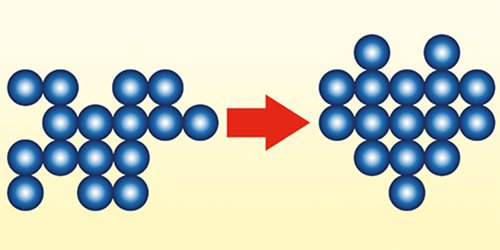Rearranging Nanoclusters Using Randomness
According to the infinite monkey theorem, a monkey randomly hitting the keys of a typewriter will eventually write something worth reading—but it might take a few trillion years of trying. For those lacking the patience to wait, Francesco Boccardo and Olivier Pierre-Louis at the University Claude Bernard Lyon 1, France, now show that randomness can deliver specific outcomes much more quickly [1]. Simulating a 2D nanocluster of a dozen particles, the researchers determine the temperature at which thermal fluctuations can most quickly rearrange those particles into a predetermined shape. They find that this time can be dramatically cut by applying an appropriate macroscopic force to the particles. The result could lead to efficient ways to fabricate components for nanoscale devices.
In their model, the particles—anything from atoms to colloidal nanoparticles—occupy a square lattice. Adjacent particles bind together, but thermal fluctuations give those on the edge of the cluster a chance of hopping to a neighboring position at each simulated time step. That hopping allows the nanocluster to evolve iteratively toward a target configuration. One might expect the speed of this evolution to increase with the thermal-fluctuation rate—that is, with temperature. But the researchers find that certain compact shapes are achieved most quickly at specific finite temperatures, above which the formation time rises.
The duo also simulated nanoclusters that were subject to a macroscopic force field, for example, metallic nanoparticles in an electric field. Like steering a marble through a tilting labyrinth, they found the optimal global force to apply at each iteration such that the nanocluster navigated the space of possible configurations several orders of magnitude more quickly. The researchers say that they hope to convince an experimentalist to realize their method soon.
–Marric Stephens
Marric Stephens is a Corresponding Editor for Physics Magazine based in Bristol, UK.
References
- F. Boccardo and O. Pierre-Louis, “Controlling the shape of small clusters with and without macroscopic fields,” Phys. Rev. Lett. 128, 256102 (2022).




